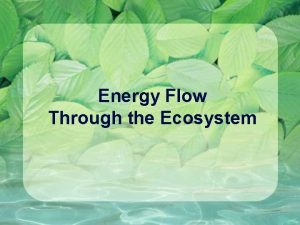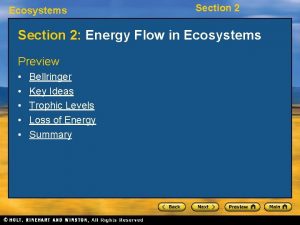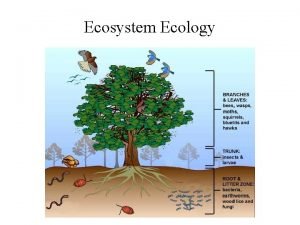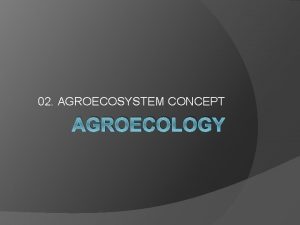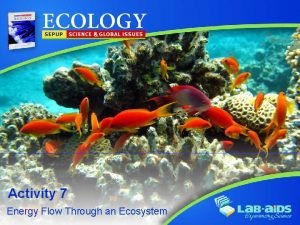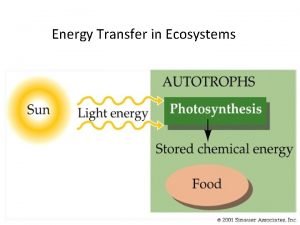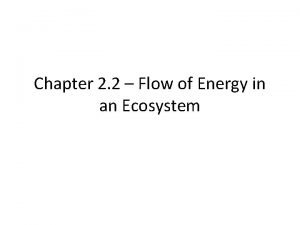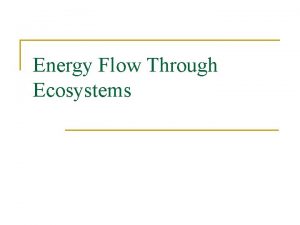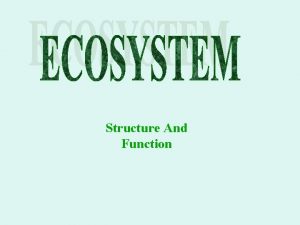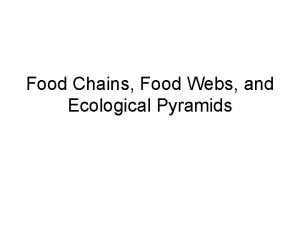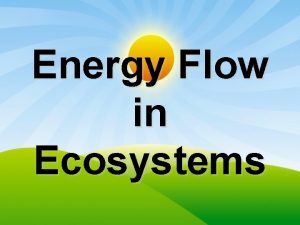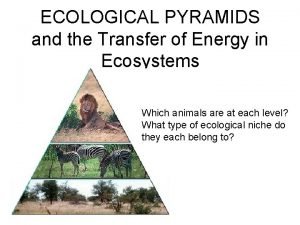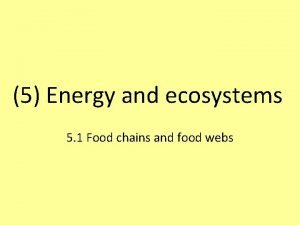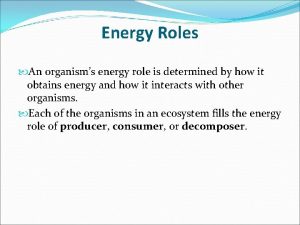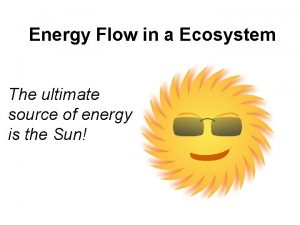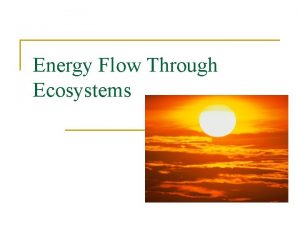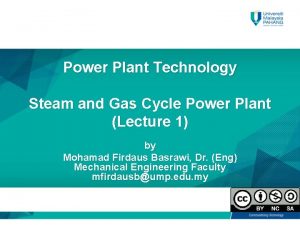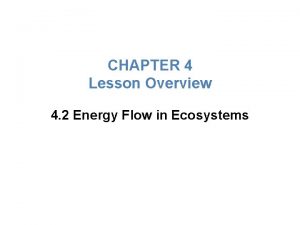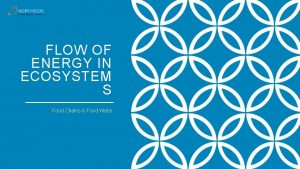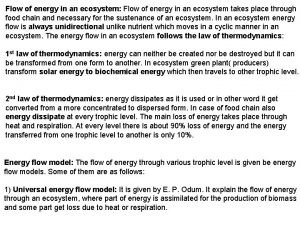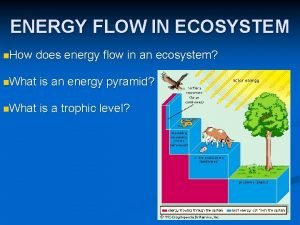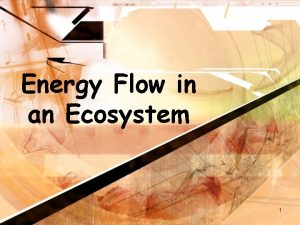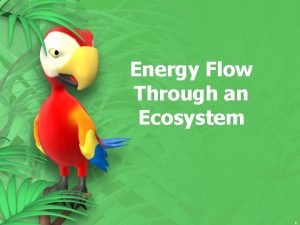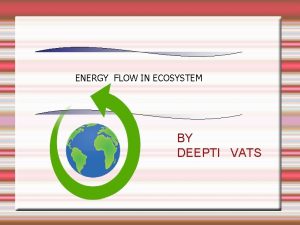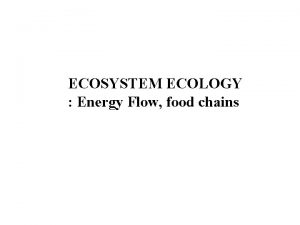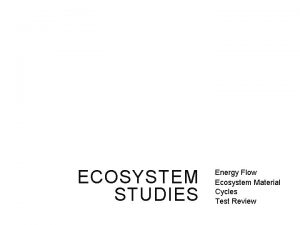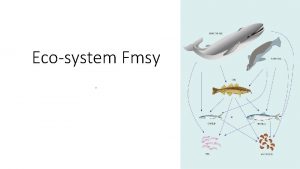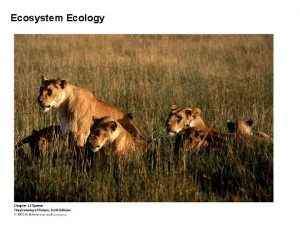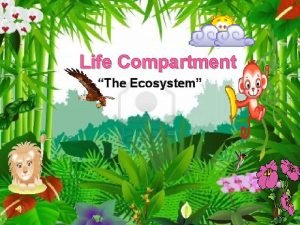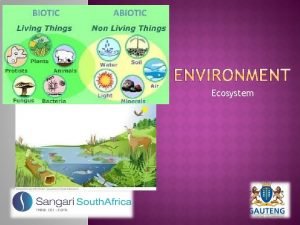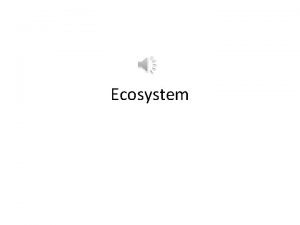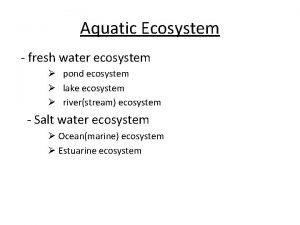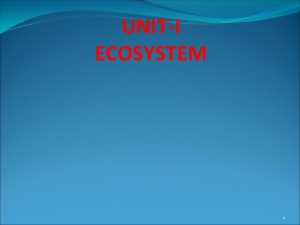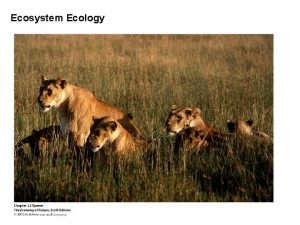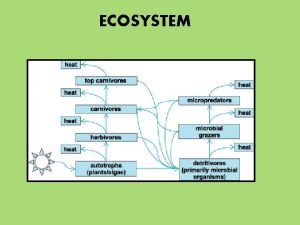Energy Flow in an Ecosystem 1 2 Energy














































- Slides: 46

Energy Flow in an Ecosystem 1

2 Energy Flow �Energy in an ecosystem originally comes from the sun �Energy flows through Ecosystems from producers to consumers �Producers (make food) �Consumers (use food by eating producers or other consumers)

3 Producers • Sunlight is the main source of energy for most life on earth. • Producers contain chlorophyll & can use energy directly from the sun

4 Autotrophs �An Autotroph is any organism that can produce its own food supply! �Autotrophs are also called Producers �Plants, algae, some protists, & some bacteria are examples

5 Niche of a Producer �Captures energy and transforms it into organic, stored energy for the use of living organisms. �May be photo-autotrophs using light energy (e. g. plants) �May be chemo-autotrophs using chemical energy (e. g. cyanobacteria)

6 Photoautotroph Producer That Captures Energy from the sun by: �Photosynthesis � Adds Oxygen to the atmosphere � Removes Carbon Dioxide from the Atmosphere Algae

7

8 Photosynthesis 6 CO 2 + 6 H 2 O + chlorophyll C 6 H 12 O 6 + 6 O 2

6 O 2 + C 6 H 12 O 6 ---> 6 H 2 O + 6 CO 2 + energy CELLULAR RESPIRATION is the chemical reaction that releases the energy (ATP) in glucose. 9

10 Cellular respiration reactions

Habitat of �On Land Photoautotrophs 11 �Plants �In The Sea �Algae �Tidal Flats & Salt Marshes �Cyanobacteria

12 Chemoautotrophs �Capture energy from the bonds of inorganic molecules such as Hydrogen Sulfide �Process is called Chemosynthesis �Often occurs in deep sea vents or gut of animals Called a Black smoker (thermal vent)

Tube Worms living in Black Smoker 13

14 Some energy in the primary consumer is STORED & not lost to the atmosphere or used by the consumer itself. This energy is available for another consumer (predator).

15 Consumers Heterotrophs eat other organisms to obtain energy. (e. g. animals) �Herbivores �Eat Only Plants �Carnivores �Eat Only Other Animals

Consumers Heterotrophs eat other organismsto obtain energy. Omnivores (Humans) Eat Plants & Animals Detritivores (Scavengers) Feed On Dead Plant & Animal Remains (buzzards) Decomposers Fungi & Bacteria

Trophic Levels, Energy Transfer and Pyramids

18 Feeding Relationships Energy flows through an ecosystem in one direction from producers to various levels of consumers

The transfer of energy from the sun to producer to primary consumer then to higher order consumers can be shown in a FOOD CHAIN. 19

Vocabulary � Trophic Levels – is the position an organism occupies in a food chain. It refers to food or feeding. � Apex predator – top level predators with few or no predators of their own.

Food Chain

Food Chains �The energy flow from one trophic level to the other is know as a food chain �Producers are at the first TROPHIC LEVEL �Primary Consumers are the SECOND TROPHIC LEVEL �Secondary consumers are at the THIRD TROPHIC LEVEL

Trophic Levels (feeding levels) 3 2 1

Food Web Most organisms eat more than JUST one organism When more organisms are involved it is know as a FOOD WEB Food webs are more complex and involve lots of organisms

Food Webs Food webs show ALTERNATIVE PATHWAYS other possible pathways through which an organism can obtain energy

Food webs

Trophic Level Grass Mouse Grasshopper Frog Owl Hawk Producer, primary consumer, secondary consumer, tertiary consumer?

Trophic Level Producer, primary consumer, secondary consumer, tertiary consumer Producer Grass 1 st Mouse 2 nd Primary consumer Grasshopper 2 nd Primary consumer Frog 3 rd Secondary consumer Owl 3 rd and 4 th Hawk 3 rd Secondary and tertiary consumer Secondary consumer


Transfer of Energy �When a lion eats a zebra, it does not get all of the energy from the zebra. �Energy lost is usually in form of heat �Energy lost from chain “link” to “link” is significant!

qfrom grass to sheep, loss is about 90%! HEAT 90% 100% Energy Available 10% Original Energy! 1% Original Energy!

Energy lost from one trophic level (energy level) to the next level can be represented by a pyramid 4⁰ CONSUMER S 3 CONSUMERS 2 CONSUMERS 1 CONSUMERS PRODUCERS

¨ Each level above only gets 10% of the energy from below - Ex: 10, 000 J of producers (plants) only give 10% of energy to primary consumers > 1, 000 J to primary consumers (snails, minnows, dragonflies) > 100 J to secondary consumers (small fish) > 10 J to tertiary consumers (big fish) > 1 J to quaternary consumers (fish hawk)

ENERGY PYRAMID 1 J 100 J 1, 000 J 10, 000 J

Energy Pyramid



�Three hundred trout are needed to support one man for a year. The trout, in turn, must consume 90, 000 frogs, that must consume 27 million grasshoppers that live off of 1, 000 tons of grass. -- G. Tyler Miller, Jr. , American Chemist (1971)

�Usually no more than 5 trophic levels since 6 th level would have very little energy to keep it alive

Ecological Pyramid • • Which level has the most energy? Which level has the most organisms? Which level has the least energy?

Pyramid of Numbers • Shows the numbers of individual organisms at each trophic level in an ecosystem. tertiary consumers 5 secondary consumers 5000 primary consumers 500, 000 producers 5, 000 • A vast number of producers are required to support even a few top level consumers.

Biomass pyramid � Biomass is a measure of the total dry mass of organisms in a given area. tertiary consumers 75 g/m 2 150 g/m 2 secondary consumers primary consumers producers 675 g/m 2 2000 g/m 2

Name the Producer, Consumers & Decomposers in this food chain: 44

45

46 Food Web

47
 How does energy flow through the ecosystem
How does energy flow through the ecosystem Section 2 flow of energy in an ecosystem
Section 2 flow of energy in an ecosystem Energy flow and material cycling in ecosystem
Energy flow and material cycling in ecosystem Agroecosystem concept
Agroecosystem concept Energy flow in ecosystem
Energy flow in ecosystem Describe the flow of energy in the kelp forest ecosystem
Describe the flow of energy in the kelp forest ecosystem Energy transfer in ecosystem
Energy transfer in ecosystem Principles of ecology 2 flow of energy in an ecosystem
Principles of ecology 2 flow of energy in an ecosystem Nutrient chain foldable
Nutrient chain foldable Energy roles in an ecosystem
Energy roles in an ecosystem How does energy flow through an ecosystem
How does energy flow through an ecosystem Ecological succession
Ecological succession Oikos meaning
Oikos meaning Deseart animals
Deseart animals In a food web what do the arrows represent
In a food web what do the arrows represent Ecosystem energy cycle
Ecosystem energy cycle Detritus food chain
Detritus food chain What is a pyramid of biomass
What is a pyramid of biomass Pyramid of energy in ecosystem
Pyramid of energy in ecosystem Sun grass grasshopper shrew owl
Sun grass grasshopper shrew owl Energy role
Energy role Ultimate source of energy in an ecosystem
Ultimate source of energy in an ecosystem Energy flow
Energy flow Absorptive atelectasis
Absorptive atelectasis Venturi mask flow rate
Venturi mask flow rate Venturi mask oxygen flow rate
Venturi mask oxygen flow rate Annubar vs pitot tube
Annubar vs pitot tube Internal and external flow
Internal and external flow Dfd to structure chart
Dfd to structure chart Data flow structure
Data flow structure Rotational flow means
Rotational flow means Internal versus external flow
Internal versus external flow Data flow vs control flow
Data flow vs control flow Flow chart of cheese making
Flow chart of cheese making Control flow and data flow computers
Control flow and data flow computers Transaction flow testing
Transaction flow testing Energy energy transfer and general energy analysis
Energy energy transfer and general energy analysis Energy energy transfer and general energy analysis
Energy energy transfer and general energy analysis Conduction or convection
Conduction or convection First law of thermodynamics in open system
First law of thermodynamics in open system Steady flow energy equation
Steady flow energy equation Chapter 4 lesson 2 energy flow in ecosystems answer key
Chapter 4 lesson 2 energy flow in ecosystems answer key Decomposers food web
Decomposers food web Energy flow
Energy flow Herbivore root word
Herbivore root word Pyramid of energy flow
Pyramid of energy flow Energy transfer in food web
Energy transfer in food web
